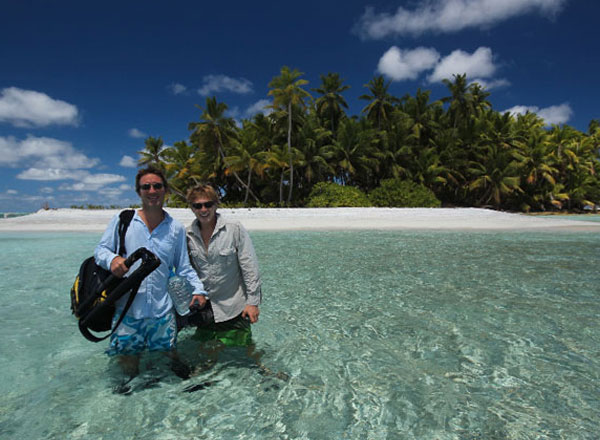Broadcast News
25/04/2016
Two Man Crews On A Budget - Filming Britain's Treasure Islands For BBC Four

I never imagined quite what a casual conversation could lead to, until I had an e-mail from the naturalist Stewart McPherson asking would I like to travel to around the globe filming a documentary on the fourteen UK Overseas Territories (sixteen if you separate Ascension and St Helena).
Such a journey would take us to every corner of the globe, from the far reaches of the icy wilds and rich wildlife havens of the Antarctic Peninsula, South Georgia and the Falklands, to the luxurious climates of the Caribbean, the Indian Ocean and the searing heat of the mid-Atlantic, then the ancient island of Pitcairn in the South Pacific and finally the home UK Territories in Europe. The resounding answer was a Yes!
Initially, Stewart has imagined the project to take one year to film. In the end it took us nearly four years spread over six separate filming blocks to complete the film project, and when complete Stewart then began to write to Britain’s Treasure Islands book, the same title as the BBC 4 broadcast series.
In the early stages of the project, we didn't clearly identify that this project could potentially make it to broadcast, but shortly after some discussions between myself and Stewart, we decided it would be worth investing in a camera that would allow us to record 50mbps 4:2:2 broadcast-quality footage, on a budget. In early 2012, I found the most budget way of acquiring this quality was by purchasing a Sony EX1 along with a nanoFLASH data recorder. The whole recorder would balance rather badly on top of the camera, and was a real pain to operate with! Every so often, the SDI cable connecting the camera to the nanoFLASH would cause a dropout, so we sometimes missed a take but soon learnt to keep an eye on the nanoFLASH record status. It served us well though, and acquired the footage we needed.
By early 2013 for our Antarctic trip, we had brought the Sony PMW-200, a really compact yet broadcast-quality camera that allowed us to be fast on our feet while still recording the quality we wanted. It was a game changer for me! Light, portable and no cables to go wrong. Now, we see cameras like this flooding the market and it's hard to imagine anything different.
During the first few filming trips, Stewart was working in between trips to try find a producer to get the series to broadcast. He would tell me, “Oh, I've spent hours meeting with a production company, or meeting this person or that person,” and a potential lead would suddenly seem very real and solid, until they would tell him they had no money or simply wanted all the rights with giving nothing in return. Finally, coming close to the mid-way in our project, Stewart found producer Steve Nicholls, then part of the Warehouse51 team.
Steve understood Stewart's vision, then took the idea up and proposed it to the Warehouse51 team, and before we knew it there was fuel in the engine!
Being a two man crew on a budget can have drawbacks, but it also has great advantages. Although I was responsible for camera, sound (radio mic usually) and data management it also meant we could keep light and fast on our feet. I can remember one of the early trips on Ascension Island when Stewart left me to film Masked Boobies for an afternoon, the peace and serenity will stay with me a lifetime, filming these beautiful seabirds circling in the mid-Atlantic sea thermals. I would be concentrating hard on the eye piece, when suddenly I would hear these unearthly 'ping-ping' noises just above my head, like a metallic musical instrument. I would look up, and see the fluttering white angelic object of the Ascension Fairy Tern, a delicate little bird that looked as though it was a sheet of pure white paper abreast on the breeze. It's large dark, round eyes would look inquisitively at me, wondering who or what this new object on the cliff top was! These birds captivated me in a way I can't describe.
Later on in early 2013 for the Falklands, Antarctic and South Georgia segment, Stewart and I had become a neat and well rehearsed team. His presenting skills had become far smoother and more natural with far less takes (far less than the 72 takes we did in underground bunkers earlier on the Ascension trip!). I also noticed that my camera work had improved, mainly because we'd invested in a better tripod (never skimp on a good tripod!), and on this this next trip to the Southern Ocean we'd brought along a Libec JB30 crane, second hand from a colleague of mine. I remember some short over-land expeditions we did while sailing around the Falklands. We'd moored up near Steeple Jason to film a large colony of breeding Black-Browed Albatross and decided to take the crane. After nearly two or three hours of lugging this huge lump of metal across the tundra, the sweeping shots over the nesting albatross chicks we filmed turned out well worth the effort! I also filmed some incredible sequences whereby the adult Albatrosses used the rough bit of ground next to the breeding site as a runaway. They would take turns to have a run at takeoff into the South Atlantic breeze, and sometimes they'd make it in to the air and sometimes on landing they would come crashing down like clumsy children only to go back round and give it another go!
Watching any albatross take flight is an example of the best aviators at work, and I can't express the sheer joy in my heart watching those birds, those natural breeding sites unaffected by humans and the rest of the world. Pure magic.
Our filming schedule was pretty packed, and I have to admit any five minute rest, on a rock or a beach, or even an iceberg was well needed! Some of the most enduring conditions come in the form of sea travel, especially at 60 degrees South, where the Oceans of the nutrient rich Antarctic waters well-up to meet the South Atlantic. We spent around a month on the boat, and probably about two non-consecutive weeks at sea. Let me tell you, I didn't quite realise how badly I suffered from seasickness until I went to Antarctica. But, would I do it again? Any day! Just a chance to see those wildlife spectacles again, the friendly waddling penguin, the albatrosses and the intimate moments of humpback feeding on huge quantities of krill next to our boat, and finally the haunting depth and colour of South Georgia's landscapes and glaciers. Truly an unforgettable experience.
So, it can be done. Regardless of your background, if you have a passion and an idea, give it a go and never give up. We are incredibly proud of the results we have achieved, and hope that the efforts of these films and Stewart's book will contribute to the ongoing protection of these vitally important eco-systems around the world to which we, the UK citizens have a say over its future.
Britain's Treasure Islands episode one will be/has been broadcast BBC 4 Tuesday 12th at 9pm and repeated Wednesday 13th at 8pm. Episode two and three will be broadcast in the following weeks but check the BBC 4 TV guide for more information.
Visit www.britainstreasureislands.com to watch over 40 'mini-documentaries' plus more information and the book about the series.
Britain's Treasure Islands filming schedule:
• Block One
Six weeks – Ascension & St Helena
During January 2012 we filmed on Ascension Island & St. Helena in mid-Atlantic which comprised
presented-led scenes on volcanic spoils and wildlife scenes during day and night.
• Block Two
Six weeks – Caribbean Territories
September 2012 filming on Bermuda, British Virgin Islands, Anguilla, Montserrat, Turks & Caicos, Cayman Islands. Filming presented-led scenes, mangrove swamps, underwater, historical and wildlife. Careful use of equipment in extremely harsh environments.
• Block Three
Seven weeks – Southern Ocean
January to March 2013 at sea filming around the Falkland Islands, South Georgia and Antarctic Peninsula, returning for pickups on Ascension Island. Countless scenes on land and at sea, including species of penguins, whales, albatross, seals, icebergs, whaling stations, historical and presenter-led sequences. Careful use of equipment in extremely harsh environments. Unique use of crane for special filming angles. – https://vimeo.com/61915237
• Block Four
Three weeks – Pacific Ocean
May & June 2013 at sea filming Pitcairn and Henderson Island. Filming ancient settlers including traditional life scenes and wildlife, including presenter-led sequences.
• Block Five
One week – Gibraltar
September 2013 on Gibraltar, filming closing sequences to documentary and historical secret WWII tunnels, including presenter-led sequences.
• Block Six
Three weeks – Indian Ocean
August to September 2014 at sea by wooden dhow and sailing boat from Maldives to the Chagos Archipelago, Indian Ocean. Filming on pristine coral reefs and islands, including presenter-led sequences.
Image of Stew and Simon, Chagos Archipelago. Credit: Jon Slayer. jonslayer.tv.
simonvacherfilm.com
Such a journey would take us to every corner of the globe, from the far reaches of the icy wilds and rich wildlife havens of the Antarctic Peninsula, South Georgia and the Falklands, to the luxurious climates of the Caribbean, the Indian Ocean and the searing heat of the mid-Atlantic, then the ancient island of Pitcairn in the South Pacific and finally the home UK Territories in Europe. The resounding answer was a Yes!
Initially, Stewart has imagined the project to take one year to film. In the end it took us nearly four years spread over six separate filming blocks to complete the film project, and when complete Stewart then began to write to Britain’s Treasure Islands book, the same title as the BBC 4 broadcast series.
In the early stages of the project, we didn't clearly identify that this project could potentially make it to broadcast, but shortly after some discussions between myself and Stewart, we decided it would be worth investing in a camera that would allow us to record 50mbps 4:2:2 broadcast-quality footage, on a budget. In early 2012, I found the most budget way of acquiring this quality was by purchasing a Sony EX1 along with a nanoFLASH data recorder. The whole recorder would balance rather badly on top of the camera, and was a real pain to operate with! Every so often, the SDI cable connecting the camera to the nanoFLASH would cause a dropout, so we sometimes missed a take but soon learnt to keep an eye on the nanoFLASH record status. It served us well though, and acquired the footage we needed.
By early 2013 for our Antarctic trip, we had brought the Sony PMW-200, a really compact yet broadcast-quality camera that allowed us to be fast on our feet while still recording the quality we wanted. It was a game changer for me! Light, portable and no cables to go wrong. Now, we see cameras like this flooding the market and it's hard to imagine anything different.
During the first few filming trips, Stewart was working in between trips to try find a producer to get the series to broadcast. He would tell me, “Oh, I've spent hours meeting with a production company, or meeting this person or that person,” and a potential lead would suddenly seem very real and solid, until they would tell him they had no money or simply wanted all the rights with giving nothing in return. Finally, coming close to the mid-way in our project, Stewart found producer Steve Nicholls, then part of the Warehouse51 team.
Steve understood Stewart's vision, then took the idea up and proposed it to the Warehouse51 team, and before we knew it there was fuel in the engine!
Being a two man crew on a budget can have drawbacks, but it also has great advantages. Although I was responsible for camera, sound (radio mic usually) and data management it also meant we could keep light and fast on our feet. I can remember one of the early trips on Ascension Island when Stewart left me to film Masked Boobies for an afternoon, the peace and serenity will stay with me a lifetime, filming these beautiful seabirds circling in the mid-Atlantic sea thermals. I would be concentrating hard on the eye piece, when suddenly I would hear these unearthly 'ping-ping' noises just above my head, like a metallic musical instrument. I would look up, and see the fluttering white angelic object of the Ascension Fairy Tern, a delicate little bird that looked as though it was a sheet of pure white paper abreast on the breeze. It's large dark, round eyes would look inquisitively at me, wondering who or what this new object on the cliff top was! These birds captivated me in a way I can't describe.
Later on in early 2013 for the Falklands, Antarctic and South Georgia segment, Stewart and I had become a neat and well rehearsed team. His presenting skills had become far smoother and more natural with far less takes (far less than the 72 takes we did in underground bunkers earlier on the Ascension trip!). I also noticed that my camera work had improved, mainly because we'd invested in a better tripod (never skimp on a good tripod!), and on this this next trip to the Southern Ocean we'd brought along a Libec JB30 crane, second hand from a colleague of mine. I remember some short over-land expeditions we did while sailing around the Falklands. We'd moored up near Steeple Jason to film a large colony of breeding Black-Browed Albatross and decided to take the crane. After nearly two or three hours of lugging this huge lump of metal across the tundra, the sweeping shots over the nesting albatross chicks we filmed turned out well worth the effort! I also filmed some incredible sequences whereby the adult Albatrosses used the rough bit of ground next to the breeding site as a runaway. They would take turns to have a run at takeoff into the South Atlantic breeze, and sometimes they'd make it in to the air and sometimes on landing they would come crashing down like clumsy children only to go back round and give it another go!
Watching any albatross take flight is an example of the best aviators at work, and I can't express the sheer joy in my heart watching those birds, those natural breeding sites unaffected by humans and the rest of the world. Pure magic.
Our filming schedule was pretty packed, and I have to admit any five minute rest, on a rock or a beach, or even an iceberg was well needed! Some of the most enduring conditions come in the form of sea travel, especially at 60 degrees South, where the Oceans of the nutrient rich Antarctic waters well-up to meet the South Atlantic. We spent around a month on the boat, and probably about two non-consecutive weeks at sea. Let me tell you, I didn't quite realise how badly I suffered from seasickness until I went to Antarctica. But, would I do it again? Any day! Just a chance to see those wildlife spectacles again, the friendly waddling penguin, the albatrosses and the intimate moments of humpback feeding on huge quantities of krill next to our boat, and finally the haunting depth and colour of South Georgia's landscapes and glaciers. Truly an unforgettable experience.
So, it can be done. Regardless of your background, if you have a passion and an idea, give it a go and never give up. We are incredibly proud of the results we have achieved, and hope that the efforts of these films and Stewart's book will contribute to the ongoing protection of these vitally important eco-systems around the world to which we, the UK citizens have a say over its future.
Britain's Treasure Islands episode one will be/has been broadcast BBC 4 Tuesday 12th at 9pm and repeated Wednesday 13th at 8pm. Episode two and three will be broadcast in the following weeks but check the BBC 4 TV guide for more information.
Visit www.britainstreasureislands.com to watch over 40 'mini-documentaries' plus more information and the book about the series.
Britain's Treasure Islands filming schedule:
• Block One
Six weeks – Ascension & St Helena
During January 2012 we filmed on Ascension Island & St. Helena in mid-Atlantic which comprised
presented-led scenes on volcanic spoils and wildlife scenes during day and night.
• Block Two
Six weeks – Caribbean Territories
September 2012 filming on Bermuda, British Virgin Islands, Anguilla, Montserrat, Turks & Caicos, Cayman Islands. Filming presented-led scenes, mangrove swamps, underwater, historical and wildlife. Careful use of equipment in extremely harsh environments.
• Block Three
Seven weeks – Southern Ocean
January to March 2013 at sea filming around the Falkland Islands, South Georgia and Antarctic Peninsula, returning for pickups on Ascension Island. Countless scenes on land and at sea, including species of penguins, whales, albatross, seals, icebergs, whaling stations, historical and presenter-led sequences. Careful use of equipment in extremely harsh environments. Unique use of crane for special filming angles. – https://vimeo.com/61915237
• Block Four
Three weeks – Pacific Ocean
May & June 2013 at sea filming Pitcairn and Henderson Island. Filming ancient settlers including traditional life scenes and wildlife, including presenter-led sequences.
• Block Five
One week – Gibraltar
September 2013 on Gibraltar, filming closing sequences to documentary and historical secret WWII tunnels, including presenter-led sequences.
• Block Six
Three weeks – Indian Ocean
August to September 2014 at sea by wooden dhow and sailing boat from Maldives to the Chagos Archipelago, Indian Ocean. Filming on pristine coral reefs and islands, including presenter-led sequences.
Image of Stew and Simon, Chagos Archipelago. Credit: Jon Slayer. jonslayer.tv.
simonvacherfilm.com
Top Related Stories
Click here for the latest broadcast news stories.
04/12/2023
Filming Begins On Cleddau/The One That Got Away
Filming has commenced on Cleddau/The One That Got Away; a new, six-part, drama series that combines a gripping murder mystery with an electrifying lov
Filming Begins On Cleddau/The One That Got Away
Filming has commenced on Cleddau/The One That Got Away; a new, six-part, drama series that combines a gripping murder mystery with an electrifying lov
16/06/2022
Filming Starts On Latest Series Of The Bay
ITV and Tall Story Pictures have announced filming has commenced on the latest series of The Bay. The fourth series sees Marsha Thomason (Cobra, White
Filming Starts On Latest Series Of The Bay
ITV and Tall Story Pictures have announced filming has commenced on the latest series of The Bay. The fourth series sees Marsha Thomason (Cobra, White
17/01/2022
ITV Detective Drama Starts Filming In Lancashire
ITV detective drama, Ridley, starring Adrian Dunbar in the title role, has started filming in Lancashire. The retired detective, who is now working in
ITV Detective Drama Starts Filming In Lancashire
ITV detective drama, Ridley, starring Adrian Dunbar in the title role, has started filming in Lancashire. The retired detective, who is now working in
08/11/2021
Jeremy Braben Aerial DoP Discusses Aerial Filming on ETERNALS
Team Involved • Jeremy Braben – Aerial DoP/Camera Operator • Jim Swanson – Aerial Camera Operator • Oliver Ward – Aerial Technician • Giles Dumper – H
Jeremy Braben Aerial DoP Discusses Aerial Filming on ETERNALS
Team Involved • Jeremy Braben – Aerial DoP/Camera Operator • Jim Swanson – Aerial Camera Operator • Oliver Ward – Aerial Technician • Giles Dumper – H
15/10/2021
BBC Studios New Series Deadly Predators Begins Filming
BBC Studios Natural History Unit has announced its new seven-part series, Deadly Predators, has begun filming in the UK. Presented by BAFTA Award-winn
BBC Studios New Series Deadly Predators Begins Filming
BBC Studios Natural History Unit has announced its new seven-part series, Deadly Predators, has begun filming in the UK. Presented by BAFTA Award-winn
05/10/2021
Filming Starts For Greenpeace Inside - Mission: Saving The Planet
Filming has commenced for Sky Original docu-series Greenpeace Inside - Mission: Saving the Planet. Greenpeace is one of the world's largest environmen
Filming Starts For Greenpeace Inside - Mission: Saving The Planet
Filming has commenced for Sky Original docu-series Greenpeace Inside - Mission: Saving the Planet. Greenpeace is one of the world's largest environmen
29/07/2016
Liverpool Welcomes Record-Breaking Year For Productions
A record number of film and TV productions were made on location in Liverpool last year, it has been revealed. In a report, which will be sent before
Liverpool Welcomes Record-Breaking Year For Productions
A record number of film and TV productions were made on location in Liverpool last year, it has been revealed. In a report, which will be sent before
06/03/2014
Suffragette To Film In House Of Commons
In April, the House of Commons is to welcome a commercial production into its iconic halls for the first time, as the filming of British feature Suffr
Suffragette To Film In House Of Commons
In April, the House of Commons is to welcome a commercial production into its iconic halls for the first time, as the filming of British feature Suffr
24/07/2008
Bollywood Comes To The North East
The first Bollywood film to be shot in the north of England for 15 years, 'Kaun Bola?' has begun filming in Newcastle. 'Kaun Bola?', which translates
Bollywood Comes To The North East
The first Bollywood film to be shot in the north of England for 15 years, 'Kaun Bola?' has begun filming in Newcastle. 'Kaun Bola?', which translates
16/05/2005
‘London Day’ in Cannes marks 'production revolution'
At the Cannes Film Festival Film London has announced "the most comprehensive revolution in film production in London for 25 years". Top British film-
‘London Day’ in Cannes marks 'production revolution'
At the Cannes Film Festival Film London has announced "the most comprehensive revolution in film production in London for 25 years". Top British film-
08/07/2008
Falklands Islands Cinema Goes Digital
In June 2008, the Falkland Islands became the world's first 100% 'digital only' territory. The island's only cinema, the Phoenix, is managed by SSVC F
Falklands Islands Cinema Goes Digital
In June 2008, the Falkland Islands became the world's first 100% 'digital only' territory. The island's only cinema, the Phoenix, is managed by SSVC F
05/07/2005
Cànan wins award at Highlands and Islands Business Awards 2005
Skye based media company Cànan was one of eight companies presented with an award at the prestigious Highlands and Islands Business Awards 2005. The a
Cànan wins award at Highlands and Islands Business Awards 2005
Skye based media company Cànan was one of eight companies presented with an award at the prestigious Highlands and Islands Business Awards 2005. The a
09/07/2001
AID FOR FILM-MAKERS IN SCOTTISH ISLANDS
FULL up-to-date details on how to go about making television and radio programmes as well as films in the Outer Hebrides - or Western Isles of Scotlan
AID FOR FILM-MAKERS IN SCOTTISH ISLANDS
FULL up-to-date details on how to go about making television and radio programmes as well as films in the Outer Hebrides - or Western Isles of Scotlan
04/07/2005
Fianuis Shuil to be broadcast on Grampian and Scottish Television
The third programme of the Gaelic series 'Fianuis Shùil' - which looks at how technology changed people’s lives - will be broadcast on Sunday July 10
Fianuis Shuil to be broadcast on Grampian and Scottish Television
The third programme of the Gaelic series 'Fianuis Shùil' - which looks at how technology changed people’s lives - will be broadcast on Sunday July 10
19/02/2016
The Sky Is Not The Limit
Insider to the filming industry know the challenges faced when requiring aerial imagery for your productions. It exponentially increases your budget r
The Sky Is Not The Limit
Insider to the filming industry know the challenges faced when requiring aerial imagery for your productions. It exponentially increases your budget r















